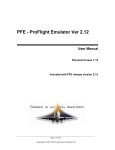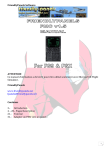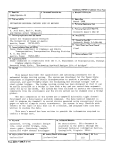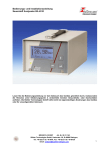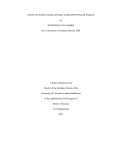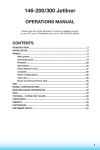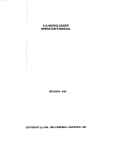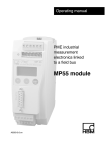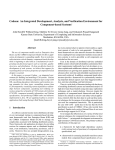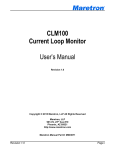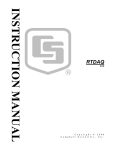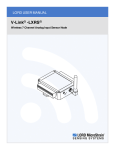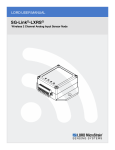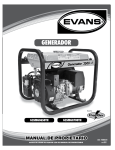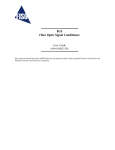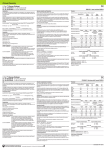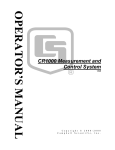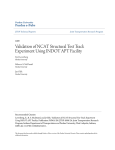Download 4WFBS120, 4WFBS350 & 4WFBS1K 4-Wire Full Bridge Terminal
Transcript
4WFBS120, 4WFBS350 & 4WFBS1K 4-Wire Full Bridge Terminal Input Modules User Manual Issued 23.4.12 Copyright © 1996-2012 Campbell Scientific Inc. Printed under licence by Campbell Scientific Ltd. CSL 887 Guarantee This equipment is guaranteed against defects in materials and workmanship. This guarantee applies for twelve months from date of delivery. We will repair or replace products which prove to be defective during the guarantee period provided they are returned to us prepaid. The guarantee will not apply to: • Equipment which has been modified or altered in any way without the written permission of Campbell Scientific • Batteries • Any product which has been subjected to misuse, neglect, acts of God or damage in transit. Campbell Scientific will return guaranteed equipment by surface carrier prepaid. Campbell Scientific will not reimburse the claimant for costs incurred in removing and/or reinstalling equipment. This guarantee and the Company’s obligation thereunder is in lieu of all other guarantees, expressed or implied, including those of suitability and fitness for a particular purpose. Campbell Scientific is not liable for consequential damage. Please inform us before returning equipment and obtain a Repair Reference Number whether the repair is under guarantee or not. Please state the faults as clearly as possible, and if the product is out of the guarantee period it should be accompanied by a purchase order. Quotations for repairs can be given on request. It is the policy of Campbell Scientific to protect the health of its employees and provide a safe working environment, in support of this policy a “Declaration of Hazardous Material and Decontamination” form will be issued for completion. When returning equipment, the Repair Reference Number must be clearly marked on the outside of the package. Complete the “Declaration of Hazardous Material and Decontamination” form and ensure a completed copy is returned with your goods. Please note your Repair may not be processed if you do not include a copy of this form and Campbell Scientific Ltd reserves the right to return goods at the customers’ expense. Note that goods sent air freight are subject to Customs clearance fees which Campbell Scientific will charge to customers. In many cases, these charges are greater than the cost of the repair. Campbell Scientific Ltd, Campbell Park, 80 Hathern Road, Shepshed, Loughborough, LE12 9GX, UK Tel: +44 (0) 1509 601141 Fax: +44 (0) 1509 601091 Email: [email protected] www.campbellsci.co.uk PLEASE READ FIRST About this manual Please note that this manual was originally produced by Campbell Scientific Inc. primarily for the North American market. Some spellings, weights and measures may reflect this origin. Some useful conversion factors: Area: 1 in2 (square inch) = 645 mm2 Length: 1 in. (inch) = 25.4 mm 1 ft (foot) = 304.8 mm 1 yard = 0.914 m 1 mile = 1.609 km Mass: 1 oz. (ounce) = 28.35 g 1 lb (pound weight) = 0.454 kg Pressure: 1 psi (lb/in2) = 68.95 mb Volume: 1 UK pint = 568.3 ml 1 UK gallon = 4.546 litres 1 US gallon = 3.785 litres In addition, while most of the information in the manual is correct for all countries, certain information is specific to the North American market and so may not be applicable to European users. Differences include the U.S standard external power supply details where some information (for example the AC transformer input voltage) will not be applicable for British/European use. Please note, however, that when a power supply adapter is ordered it will be suitable for use in your country. Reference to some radio transmitters, digital cell phones and aerials may also not be applicable according to your locality. Some brackets, shields and enclosure options, including wiring, are not sold as standard items in the European market; in some cases alternatives are offered. Details of the alternatives will be covered in separate manuals. Part numbers prefixed with a “#” symbol are special order parts for use with non-EU variants or for special installations. Please quote the full part number with the # when ordering. Recycling information At the end of this product’s life it should not be put in commercial or domestic refuse but sent for recycling. Any batteries contained within the product or used during the products life should be removed from the product and also be sent to an appropriate recycling facility. Campbell Scientific Ltd can advise on the recycling of the equipment and in some cases arrange collection and the correct disposal of it, although charges may apply for some items or territories. For further advice or support, please contact Campbell Scientific Ltd, or your local agent. Campbell Scientific Ltd, Campbell Park, 80 Hathern Road, Shepshed, Loughborough, LE12 9GX, UK Tel: +44 (0) 1509 601141 Fax: +44 (0) 1509 601091 Email: [email protected] www.campbellsci.co.uk Contents PDF viewers: These page numbers refer to the printed version of this document. Use the PDF reader bookmarks tab for links to specific sections. 1. Function ....................................................................... 1 2. Specifications .............................................................. 1 3. Measurement Concepts .............................................. 2 4. Quarter Bridge Strain .................................................. 3 4.1 Quarter Bridge Strain with 3 Wire Strain Element .................................. 4 4.1.1 Quarter Bridge Strain with 3 Wire Element Wiring ....................... 4 4.1.1.1 Quarter Bridge Strain with 3 Wire Element Wiring using a multiplexer ...................................................................... 5 4.1.2 Quarter Bridge Strain with 3 Wire Element Calculations .............. 6 4.1.3 Quarter Bridge Strain with 3 Wire Program Examples .................. 6 4.1.3.1 CRBasic Programming ......................................................... 6 4.1.3.2 Edlog ................................................................................... 11 4.2 Quarter Bridge Strain with 2 Wire Element ........................................... 17 4.2.1 Quarter Bridge Strain with 2 Wire Element Wiring ..................... 17 4.2.2 Two Wire ¼ Bridge use with Multiplexers and Equations .......... 18 4.3 Quarter Bridge Strain with Dummy Gauge............................................ 18 4.3.1 Quarter Bridge Strain with Dummy Gauge Wiring Setup ........... 19 4.3.2 Quarter Bridge Strain with Dummy Gauge Calculations ............. 20 4.3.3 Quarter Bridge Strain with Dummy Gauge Example Programs... 21 4.4 Quarter Bridge Strain Lead Resistance Compensation .......................... 21 4.4.1 Mathematical Lead Compensation for 3-Wire, ¼ Bridge Strain .. 21 4.4.1.1 Mathematical Lead Compensation Circuit and Equations .. 21 4.4.1.2 Mathematical Lead Compensation Programs ..................... 23 4.4.2 Shunt Calibration Lead Compensation for 3-Wire, ¼ Bridge Strain......................................................................................... 30 4.4.2.1 Three Wire Gauge Circuit with Shunt ................................ 30 4.4.2.2 Math for Shunt Calibration of 3-Wire, ¼ Bridge Strain Circuits............................................................................. 32 4.4.2.3 Example Programs for Shunt Calibration of 3-Wire, ¼ Bridge Strain Circuits .................................................. 34 4.4.3 Lead Compensation using Quarter Bridge Strain with 2 Wire Element ..................................................................................... 35 4.5 Calculation of Strain for ¼ Bridge Circuits ........................................... 37 i Figures 1-1. Terminal Input Module with CR1000 ..................................................... 1 2-1. Schematic ................................................................................................ 2 3-1. Strain definition....................................................................................... 2 4.1-1. Three wire quarter bridge strain circuit ................................................ 4 4.1-2. 3-wire ¼ bridge strain wiring ............................................................... 5 4.1-3. 3-wire ¼ bridge strain with multiplexer wiring ................................... 5 4.2-1. Two wire quarter bridge strain circuit ................................................ 17 4.2-2. Wiring for 2-wire gauges ................................................................... 18 4.3-1. Quarter bridge strain circuit with dummy gauge ............................... 19 4.3-2. ¼ bridge strain with remote dummy gauge ........................................ 20 4.3-3. ¼ bridge strain with dummy gauge at datalogger .............................. 20 4.4-1. Three wire ¼ bridge strain circuit ...................................................... 22 4.4-2. Shunting remotely across active gauge .............................................. 31 4.4-3. Circuit for shunting across dummy resistor ....................................... 31 4.4-4. Wiring for shunt across dummy resistor ............................................ 32 4.4-5. Two wire quarter bridge strain circuit ................................................ 35 4.5-1. Strain gauge in full bridge .................................................................. 37 Table 4-1. Input Locations Used in CR10(X), 21X, and CR7 Examples ............... 11 ii 4WFBS120, 4WFBS350, 4WFBS1K 4 Wire Full Bridge Terminal Input Modules (TIM) 1. Function The 4WFBS120, 4WFBS350, and 4WFBS1K Terminal Input Modules (TIM) complete a full Wheatstone bridge for a single strain gauge or other sensor that acts as a single variable resistor. The difference between the three models is in the resistor that matches the nominal resistance of a 120 ohm, 350 ohm, or 1000 ohm quarter bridge strain gauge. It can also be used to complete the back half of a Wheatstone bridge for use in a ¼ bridge strain circuit (1 active element) using a dummy gauge, or in a ½ bridge strain circuit (2 active elements). Figure 1-1. Terminal Input Module with CR1000 2. Specifications 2:1 Resistive Divider Resistors: Ratio tolerance @ 25 °C: Ratio temperature coefficient: Power rating per element: 1 kΩ/1 kΩ ±0.01% 0.5 ppm/°C (-55°C to 85°C) 0.1 W @ 70°C Completion Resistor: 120, 350, or 1000 Ω ±0.01% Tolerance @ 25 °C: Temperature coefficient: ±0.8 ppm °C-1 (-55°C to 85°C) Power rating: 0.25 W @ 70°C 1 4WFBS120, 4WFBS350, 4WFBS1K 4 Wire Full Bridge Terminal Input Modules (TIM) Figure 2-1. Schematic 3. Measurement Concepts Measuring strain is measuring a change in length. Specifically, the unit strain (ε ) is the change in length divided by the unstrained length ε = Δ L / L , and thus is dimensionless. ( LT + ΔLT ) LT L P P L + ΔL Figure 3-1. Strain definition As the subject is elongated in the longitudinal direction, the material will be narrowed or thinned down in the transverse direction. The ratio of the transverse strain to the longitudinal strain is known as the Poisson ratio (ν). ΔLT ν= ΔL LT L 3.1 This Poisson ratio is a known property for most materials and is used in some half bridge strain and full bridge strain circuits. Strain is typically reported in microstrain ( με ) . Microstrain is strain expressed in parts per million, i.e.: a change in length divided by one millionth of the length. A metal foil strain gauge is a resistive element that changes resistance as it is stretched or compressed. The strain gauge is bonded to the object in which strain is measured. The gauge factor, GF , is the ratio of the relative change in resistance to the change in strain: GF = Δ R / R Δ l / l . For example, a gauge factor of 2 means that if the length changes by one micrometer per metre of length (1 με ) , the resistance will change by two micro-ohms per ohm of resistance. A more common method of portraying this equation is: 2 User Manual ε= ΔRG GF • RG 3.2 Or in terms of micro-strain: με = (1×10 )ΔR 6 G GF • RG 3.3 Because the actual change in resistance is small, a full Wheatstone bridge configuration is used to give the maximum resolution. The Wheatstone bridge can be set up with 1 active gauge (Quarter bridge strain circuit), two active gauges (Half bridge strain circuit), or 4 active gauges (Full bridge strain circuit). For each of these Wheatstone bridge circuits there are multiple configurations. The 4WFBS module provides three resistors that can be used for three of the arms of the Wheatstone Bridge (Figure 4-1). There are two 1000 ohm precision resistors for the back plane of the Wheatstone bridge, and a resistor matching the strain gauge's resistance for the bridge arm opposite the gauge. The inputs of the 4WFBS are configured so that this matching resistor can be bypassed if it is desired to utilize a dummy gauge, or to use two active gauges (Half Bridge Strain circuit). For Full Bridge Strain circuits, as all four arms of the Wheatstone bridge are active gauges, there is no need for completion resistors, and thus a 4WFBS module is not required. The resistance of an installed gauge will differ from the nominal value. In addition, lead resistance imbalances can result in further unbalancing of the bridge. A zero measurement can be made with the gauge installed. This zero measurement can be incorporated into the datalogger program such that subsequent measurements can report strain relative to this zero basis point. This removes the apparent strain resulting from the initial bridge imbalance. Strain is calculated in terms of the result of the full bridge measurement. This result is the measured bridge output voltage divided by the bridge excitation voltage: Vout / Vex . All of the various equations that are used to calculate strain use Vr, the change in the bridge measurement from the zero state: Vr = (Vout / Vex ) Strained − (Vout / Vex ) Zero 3.4 The result of the zero measurement, ⋅ (Vout / Vex )Zero , can be stored and used in the calculation of future strain measurements. Alternatively, the zero reading value can be left at 0 (zero measurement is neither recorded nor used). It should be noted the actual result of the full bridge instruction (BrFull) is the millivolts output per volt of excitation (1000 ⋅Vout / Vex ). The StrainCalc function used in CRBasic uses this raw output as its input to calculate µstrain. See Section 4.5 Calculation of Strain for ¼ Bridge Circuits for a detailed derivation of the equations used. 4. Quarter Bridge Strain A "quarter bridge strain circuit" is so named because an active strain gauge is used as one of the four resistive elements that make up a full Wheatstone bridge. The 3 4WFBS120, 4WFBS350, 4WFBS1K 4 Wire Full Bridge Terminal Input Modules (TIM) other three arms of the bridge are composed of inactive elements. There are various circuits that use a single active element, including 2-Wire gauges, 3-Wire gauges, as well as a few circuits that utilize a dummy gauge for the arm opposite the arm holding the active gauge instead of a resistor, RD in Figure 4.1.-1 (See Figures 4.3-1, 4.3-2, and 4.3-3). The 4WFBS TIM modules can support all types of these ¼ Bridge Strain circuits. 4.1 Quarter Bridge Strain with 3 Wire Strain Element A 3-wire quarter bridge strain circuit is shown in figure 4.1-1. Strain gauges are available in nominal resistances of 120, 350, and 1000 ohms. The 4WFBSXXX model must match the nominal resistance of the gauge when using the 3-Wire circuit (e.g., the 4WFBS120 is used with a 120 ohm strain gauge). In Figure 4.1-1, R1 and R2 are 1000 ohm resistors making up the back plane of the Wheatstone bridge, as is done in the TIM design. RD, the third resistive element, is the complementary resistor that has a nominal resistance of the un-strained gauge. The 4th resistive element is the active strain gauge. RD R2=1 KΩ Excite V R1=1 KΩ + L3 R4 = Gauge L2 L1 Figure 4.1-1. Three wire quarter bridge strain circuit The 3-Wire gauge alleviates many of the issues of the 2-Wire gauge. As can be seen in Figure 4.1-1, lead wire L3 is in the arm of the Wheatstone bridge that has the completion resistor while lead wire L1 is in the arm that has the active gauge. L2 is tied back to the input channel of the datalogger that has an input resistance greater than 1 Gohm, thus the current flow is negligible, negating effects of L2’s resistance. This circuit nulls temperature induced resistance changes in the leads as well as reduces the sensitivity effect that the wires have on the gauge. See Section 4.4 for more on Lead resistance effects and methods to compensate for them. 4.1.1 Quarter Bridge Strain with 3 Wire Element Wiring Figure 4.1-2 illustrates the wiring of the strain gauge to the 4WFBS module and the wiring of the module to the datalogger. It is important that the gauge be wired as shown, and that the leads to the L and G terminals be the same length, diameter, and wire type. It is preferable to use a twisted pair for these two wires so that they will undergo the same temperature and electromagnetic field variations. With this configuration, changes in wire resistance due to temperature occur equally in both arms of the bridge with negligible effect on the output from the bridge. 4 User Manual Datalogger 4WFBSXXX TIM Shunt Receptacle VX or EX H R1=1KΩ Active Gauge R2 =1KΩ AG RD L or G Shunt Receptacle Figure 4.1-2. 3-wire ¼ bridge strain wiring 4.1.1.1 Quarter Bridge Strain with 3 Wire Element Wiring using a multiplexer When using a mechanical relay multiplexer such as the AM16/32B, the 4WFBS module should normally be placed on the face of the multiplexer similar as shown in Figure 4.1-3. AM16/32B Relay Multiplexer 4WFBS 2 G CLK GND 3 3 4 H L H 12V L RES 2 H 4X16 ODD H L 1 L H 5 L H COM EVEN H L H L 7 13 L N O 2X32 CR10X 12 11 22 21 H L H 13 23 L H 25 24 L H L H CR23X CR1000 CR3000 CR5000 21X CR7 CR800 CR850 AG L E1–E3 Cable Shield EX1–EX4 EX1–EX3 or VX1–VX4 VX1–VX3 EXCITATION SWITCHED 1–4 ANALOG OUT EX1–EX2 or VX10VX2 1L 1L 1L 1L 1L 1L 1L 1H 1H 1H 1H 1H 1H 1H CR800 CR850 CR10X CR1000 CR3000 CR23X CR5000 21X CR7 G G 12 V 12 V 12 V +12 V 12 V G G G C1–C4 C1–C8 C1–C8 C1–C4 C1–C8 C1–C8 EXCIT 1–4 EXCITATION C1–C6 725 Card Control Figure 4.1-3. 3-wire ¼ bridge strain with multiplexer wiring Although this requires a 4WFBS module for each strain gauge, it is important because placing relays internal a Wheatstone bridge strain system is discouraged. Any change in resistance of the multiplexer’s relay contacts would result in a corresponding change in the bridge’s output voltage. Changes in contact resistance can be induced by temperature fluctuations, oxidation, environmental conditions, and normal wear of contact surfaces. The specification for the relays that are used in our multiplexers state that initial contact resistance will be less than 100 milliohms (AM16/32B). There is not a specification for change in contact resistance for the relays because there are so many variables that affect contact resistance. Test reports exist for various test conditions that show contact resistance changing over time by 10 to 20 milliOhms. These tests were performed using static test temperatures, so it is safe to assume that real world conditions would result in larger resistance shifts. 5 4WFBS120, 4WFBS350, 4WFBS1K 4 Wire Full Bridge Terminal Input Modules (TIM) When strain gauges are used in the Wheatstone bridge, small changes in contact resistance result in large apparent strains. To understand the error that can be introduced from allowing the relay contacts to be internal of the Wheatstone bridge, let us assume that the two relays carrying the current from the strain gauge vary by 20 milliohms (40 milliohm total variance or ΔRG = 40 mΩ ). Inserting this into equation 3.3, using a 120 ohm strain gauge with a gauge factor of 2 results in an apparent strain of about 167 με. 167με = (1× 10 )× 0.04Ω 6 2 × 120Ω 4.1.2 Quarter Bridge Strain with 3 Wire Element Calculations As noted in Section 3, in real life applications the Wheatstone bridge starts out unbalanced. The strain gauge is never perfectly at its nominal resistance even prior to installation. The installation process can lead to even more deviation from this nominal state. In addition, lead resistance can cause an initial apparent strain reading. To remove this initial offset, a zero measurement can be made with the gauge installed. This zero measurement can be incorporated into the datalogger program and subsequent measurements can report strain relative to this zero basis point. Strain is calculated in terms of the result of the full bridge measurement. This result is the measured bridge output voltage divided by the bridge excitation voltage Vout / Vex . (The actual result of the full bridge instruction is the millivolts output per volt of excitation, 1000 ⋅Vout / Vex ) The result of the zero measurement, 1000 ⋅Vout 0 / Vex can be stored and used to calculate future strain measurements. The change in the full bridge measurement from the zero state, Vr, is used in the calculation of the strain. Vr = (Vout / Vex ) − (Vout 0 / Vex ) 4.1.1 Using Vr from equation 4.1.1, the strain is calculated using equation 4.1.2. ε = 4V r GF (1 − 2V r ) 4.1.2 The calculations are covered in more detail in Section 4.5. 4.1.3 Quarter Bridge Strain with 3 Wire Program Examples This section is broken out into CRBasic programs and EDLOG programs. These programs are only to be used as examples. Besides adding additional measurement instructions, the programs will need to have the scan and data storage intervals altered for actual applications. Refer to the datalogger’s manuals and/or the CRBasic Editor’s help files for detailed information on the program instructions used as well as additional program examples. 4.1.3.1 CRBasic Programming Dataloggers that use CRBasic include our CR800, CR850, CR1000, CR3000, CR5000, and CR9000(X). CRBasic uses the StrainCalc Instruction for calculating strain from the output of different full bridge configurations: StrainCalc(Dest,Reps,Source,BrZero,BrConfig,GaugeFactor,PoissonRatio) Source is the variable holding the current result from the full bridge measurement 6 User Manual BrZero is the zero measurement; this parameter uses the results of a previous full bridge measurement instruction when the gauge is at the zero condition (multiplier=1, offset=0, mV/V) directly. BRCode for the Bridge Configuration used with the 4WFBS module should be set to -1 for a quarter bridge strain circuit. Enter the actual gauge factor in the GaugeFactor parameter. Enter 0 for the Poisson ratio parameter, which is not used with ¼ Bridge strain circuits. Example Program 4.1. CR9000X ¼ bridge Strain with 3 reps This example program measures the output from the Wheatstone bridge using the BrFull instruction. The output from this instruction is input into the StrainCalc instruction in order to calculate the raw µstrain value. This program does not use a zero offset reading. See Example Program 4.2 for an example that performs a zero calibration. ' Program name: STRAIN.C9X Public StrainMvperV(3) : Units StrainMvperV = mV_per_V Public Strain(3) : Units Strain = uStrain Public GF(3) 'Raw Strain dimensioned source ‘uStrain dimensioned source 'Dimensioned gauge factor DataTable(STRAIN,True,-1) DataInterval(0,0,0,100) CardOut(0,-1) Sample (3,Strain(),IEEE4) Sample (3,StrainMvperV(),IEEE4) EndTable 'Trigger, auto size 'Synchronous, 100 lapses, autosize 'PC card , size Auto '3 Reps, uStrain, Resolution ‘3Reps,Stain mVolt/Volt, Resolution 'End of table STRAIN BeginProg GF(1) = 2.1 : GF(2) = 2.2 'Program begins here 'Initialize gauge factors for Strain( ) : GF(3) = 2.3 7 4WFBS120, 4WFBS350, 4WFBS1K 4 Wire Full Bridge Terminal Input Modules (TIM) Scan(10,mSec,100,0) 'Scan once every 10 mSecs, non-burst BrFull(StrainMvperV(),3,mV50,4,1,5,7,1,5000,True,True,70,100,1,0) StrainCalc(Strain(),3,StrainMvperV(),0,-1,GF(),0) 'Strain calculation CallTable STRAIN Next Scan 'Loop up for the next scan SlowSequence Scan(1,Sec,0,0) Calibrate BiasComp Next Scan EndProg 'Slow sequence Scan to perform temperature ' compensation on DAQ 'Corrects ADC offset and gain 'Corrects ADC bias current 'Program ends here Example Program 4.2. CR9000X ¼ bridge Strain with 3 reps and zero offset This example program starts out with Example Program 4.1 and adds instructions (highlighted) to perform a zero calibration. As all strain circuits have a zero or initial imbalance that is related to the circuit rather than the member undergoing strain, a zero reading is often used to offset or remove this apparent strain. Again, see the manual and CRBasic editor’s Help file for more in-depth discussion on the instructions. The FieldCalStrain instruction takes care of the underlying math for the zeroing using equation 4.1.2. The LoadFieldCal instruction facilitates the reloading of the calibration factors when the logger is powered up. In addition, the programmer should create a DataTable (we have called this DataTable Calib in the example) to store the calibration factors each time a calibration is done. The NewFieldCal is a Boolean flag variable that is only high during the Scan that a calibration has been completed. It is used in the DataTable instruction’s trigger parameter to trigger the table to record a record. The SampleFieldCal output instruction is used to inform the logger to store all of the calibration factors that are controlled using the FieldCalStrain instruction. ' Program name: STRAIN0.C9X Public StrainMvperV(3) : Units StrainMvperV = mV_per_V Public Strain(3) : Units Strain = uStrain Public GF(3) Public ZeromV_V(3), ZeroStrain(3) Public ZReps, ZIndex, ModeVar 8 'Raw Strain dimensioned source ‘uStrain dimensioned source 'Dimensioned gauge factor DataTable(STRAIN,True,-1) DataInterval(0,0,0,100) CardOut(0,-1) Sample (3,Strain(),IEEE4) Sample (3,StrainMvperV(),IEEE4) EndTable 'Trigger, auto size 'Synchronous, 100 lapses, autosize 'PC card , size Auto '3 Reps, uStrain, Resolution ‘3Reps,Stain mVolt/Volt, Resolution 'End of table STRAIN DataTable (Calib,NewFieldCal,10) SampleFieldCal EndTable ‘Table for calibration factors from zeroing ‘User should collect these to his computer ‘for future reference User Manual BeginProg 'Program begins here GF(1) = 2.1 : GF(2) = 2.2 : GF(3) = 2.3 'Initialize gauge factors for Strain( ) ZReps = 3 : ZIndex = 1 ‘initialize cal reps and index pointer LoadFieldCal(True) ‘Load prior calibration factors Scan(10,mSec,100,0) 'Scan once every 10 mSecs, non-burst FieldCalStrain(10,StrainMvperV(),ZReps,0,ZeromV_V(),ModeVar,0,ZIndex,1,0,Strain()) BrFull(StrainMvperV(),3,mV50,4,1,5,7,1,5000,True,True,70,100,1,0) StrainCalc(Strain(),3,StrainMvperV(),ZeromV_V(),-1,GF(),0) 'Strain calculation CallTable STRAIN CallTable Calib Next Scan 'Loop up for the next scan SlowSequence Scan(1,Sec,0,0) Calibrate BiasComp Next Scan EndProg 'Slow sequence Scan to perform 'temperature compensation on the DAQ 'Corrects ADC offset and gain 'Corrects ADC bias current 'Program ends here Example Program 4.3. CR1000 ¼ Bridge Strain with 3 reps and zero offset This example program performs the same tasks as Example Program 4.2, only it is a CR1000 program instead of a CR9000X program. There are slight differences such as range codes and the fact that the CR1000 does not have a Slot parameter for its measurement instructions. This program is more similar to what a CR800, CR3000, or a CR5000 program would look like than the CR9000X program. ' Program name: STRAIN0.CR1 Public StrainMvperV(3) : Units StrainMvperV = mV_per_V Public Strain(3) : Units Strain = uStrain Public GF(3) Public ZeromV_V(3), ZeroStrain(3) Public ZReps, ZIndex, ModeVar 'Raw Strain dimensioned source ‘uStrain dimensioned source 'Dimensioned gauge factor DataTable(STRAIN,True,-1) DataInterval(0,0,0,100) CardOut(0,-1) Sample (3,Strain(),IEEE4) Sample (3,StrainMvperV(),IEEE4) EndTable 'Trigger, auto size 'Synchronous, 100 lapses, autosize 'PC card , size Auto '3 Reps, uStrain, Resolution ‘3Reps,Stain mVolt/Volt, Resolution 'End of table STRAIN DataTable (Calib,NewFieldCal,10) SampleFieldCal EndTable ‘Table for calibration factors from zeroing ‘User should collect these to his computer ‘for future reference BeginProg 'Program begins here GF(1) = 2.1 : GF(2) = 2.2 : GF(3) = 2.3 'Initialize gauge factors for Strain( ) ZReps = 3 : ZIndex = 1 ‘initialize cal reps and index pointer LoadFieldCal(True) ‘Load prior calibration factors Scan(100,mSec,100,0) 'Scan once every 10 mSecs, non-burst FieldCalStrain(10,StrainMvperV(),ZReps,0,ZeromV_V(),ModeVar,0,ZIndex,1,0,Strain()) BrFull(StrainMvperV(),3,mV7_5,1,1,3,2500,True,True,450,500,1,0) StrainCalc(Strain(),3,StrainMvperV(),ZeromV_V(),-1,GF(),0) 'Strain calculation CallTable STRAIN CallTable Calib Next Scan 'Loop up for the next scan 9 4WFBS120, 4WFBS350, 4WFBS1K 4 Wire Full Bridge Terminal Input Modules (TIM) Example Program 4.3. CR1000 ¼ Bridge Strain using an AM16/32B Multiplexer with 16 reps and zero offset This example program has 16 strain gauges multiplexed through an AM16/32 Multiplexer and uses FieldCalStrain for zeroing. Program name: QuarterStrain with Zero and Mux.CR1 ' ' This is only an example program and should be used only for help in creating a usable program ' ----------------------------------------------- WIRING ---------------------------------------------------------' CR1000 to AM16/32 Multiplexer Control ' C1 (Control Port 1) Res (Reset) ' C2 (Control Port 2) Clk (Clock) 'G GND (Ground) ' 12V 12V ' CR1000 to AM16/32 Common TIMs to AM16/32 Banks ' Diff 1H to Common Even Hi Blk Wire to Bank Odd Lo ' Diff 1L to Common Even Lo TIM H to Bank Even Hi ' EX1 to Common Odd Lo Tim L to Bank Even Lo ' AG to Common Gnd Tim AG to Bank Even AG '\\\\\\\\\\\\\\\\\\\\\\\DECLARE VARIABLES and CONSTANTS /////////////////////// Const REPS = 16 'Strain gauge sensor count Public MVpV(REPS) : Units MVpV = mV_V 'mV per Volt output from Bridge Measurement Public STRAIN(REPS) : Units STRAIN = uStrain 'Variable where uS is stored, Const BATCH_GF = 2.1 : Public GF(REPS) 'Batch Gauge Factor Public mV_VZero(REPS) : Units mV_VZero = mV_V 'Variable for Zero mV per V reading Public CalReps, ZeroMode, ZeroStartIdx, ZeroCalAvgs 'Used by wizard for zeroing Public CalFileLoaded As Boolean Dim I '\\\\IF DESIRED (NOT REQUIRED): GIVE STRAIN VARIABLES UNIQUE ALIAS NAMES //////// Alias STRAIN(1) = Strain1 : Alias STRAIN(2) = Strain2 : Alias STRAIN(3) = Strain3 Alias STRAIN(4) = Strain4 : Alias STRAIN(5) = Strain5 : Alias STRAIN(6) = Strain6 Alias STRAIN(7) = Strain7 : Alias STRAIN(8) = Strain8 : Alias STRAIN(9) = Strain9 Alias STRAIN(10) = Strain10 : Alias STRAIN(11) = Strain11 : Alias STRAIN(12) = Strain12 Alias STRAIN(13) = Strain13 : Alias STRAIN(14) = Strain14 : Alias STRAIN(15) = Strain15 Alias STRAIN(16) = Strain16 '\\\\\\\\\\\\\\\\\\\\\\\\ OUTPUT SECTION //////////////////////// ' Table STRAIN stores uStrain and raw mV per Volt measurements to the PC Card DataTable(STRAIN,True,-1) 'Trigger, auto size DataInterval(0,0,0,100) 'Synchronous, 100 lapses CardOut(0,-1) 'PC card , Autosize Sample (REPS,STRAIN(),IEEE4) 'Sample uStrain Sample (Reps,mVpV(),IEEE4) 'Sample raw mV per Volt values EndTable 'End of table ' Table CalHist uses SampleFieldCal which stores all of the Calibration constants ' When a calibration function is complete, user should always collect this Table as a record DataTable(CalHist,NewFieldCal,50) SampleFieldCal EndTable '\\\\\\\\\\\\\\\\\\\\\\\\MAIN PROGRAM SECTION //////////////////////// BeginProg 'Program begins here For I = 1 To REPS ' For the 16 gauges GF(I) = BATCH_GF 'Assign default gauge factor (2.1) to GF array elements Next I 'Loop back up until complete CalFileLoaded = LoadFieldCal(1) 'Load the Cal constants if program signature matches 10 User Manual Scan(1,Sec,10,0) 'Scan once a Second PortSet (1 ,1 ) 'Turn on AM16/32 using C1 I=1 Delay (0,150,mSec) 'required Delay for AM16/32 multiplexer SubScan (0,0,16) PulsePort (2,10000) 'Pulse port C2 hi and low to clock the multiplexer BrFull(MVpV(I),1,mV7_5C,1,VX1,1,2500,True,True,250,500,1,0) 'Full Bridge measurement StrainCalc(Strain(I),1,MVpV(I),mV_VZero(I),-1,GF(I),0) 'Strain calculation I=I+1 'Increment I NextSubScan PortSet (1 ,0 ) 'Turn on AM16/32 using C1 FieldCalStrain(10,MVpV(),CalReps,0,mV_VZero(),ZeroMode,0,ZeroStartIdx,ZeroCalAvgs,0,STRAIN()) CallTable CalHist CallTable STRAIN Next Scan 'Loop up for the next scan EndProg 'Program ends here 4.1.3.2 Edlog The following examples for the CR10(X), 21X, and CR7 all have subroutines that measures the unstrained "zero" output of the strain gauge. The examples calculate strain using equation 4.1.2 for a strain gauge with a GF=2. These are just examples. Besides adding additional measurement instructions, the programs will probably need to have the scan and data storage intervals altered for actual applications. The instructions in the subroutine will also need to be modified for the actual gauge factor. Dataloggers that use Edlog include CR510, CR10(X), 21X, and CR7. The Edlog instruction that is used to measure strain gauges is Instruction 6 – Full Bridge. The Input Locations assignments used in CR10(X), 21X, and CR7 Examples are listed in Table 4-1. Table 4-1. Input Locations Used in CR10(X), 21X, and CR7 Examples Addr 1 2 3 4 5 6 7 8 9 10 Name mVperV mVperV_0 Vr uStrain Count GF _4e6 Mult 1_2Vr Vr_1_2Vr 11 4WFBS120, 4WFBS350, 4WFBS1K 4 Wire Full Bridge Terminal Input Modules (TIM) Example Program 4.4. CR10X ¼ Bridge Strain with 1 rep and zero offset ;{CR10X} *Table 1 Program 01: 1 Execution Interval (seconds) 1: If Flag/Port (P91) 1: 21 Do if Flag 1 is Low 2: 1 Call Subroutine 1 ;On the first execution (Flag 1 is low) ;or when user sets Flag 1 low ;call the zeroing subroutine 2: Full Bridge (P6) 1: 1 2: 22 3: 1 4: 1 5: 2500 6: 1 7: 1 8: 0 ;Measure the strain gauge Reps ± 7.5 mV 60 Hz Rejection Range DIFF Channel Excite all reps withExchan 1 mV Excitation Loc [ mVperV ] Mult Offset 3: X-Y (P35) 1: 1 2: 2 3: 3 X Loc [ mVperV ] Y Loc [ mVperV_0 ] Z Loc [ Vr ] 4: X*F (P37) 1: 3 Loc [ Vr ] 2: 0.001 3: 3 Loc [ Vr ] ;The following instructions calculate microstrain 5: Z=X*F (P37) 1: 3 X Loc [ Vr ] 2: -2 F 3: 9 Z Loc [ 1_2Vr ] 6: Z=Z+1 (P32) 1: 9 Z Loc [ 1_2Vr 7: Z=X/Y (P38) 1: 3 2: 9 3: 10 X Loc [ Vr ] Y Loc [ 1_2Vr ] Loc [ Vr_1_2Vr ] ;Subtract zero reading from the ;measurement ;Change Vr from mV/V to V/V ] 8: Z=X*Y (P36) 1: 10 X Loc [ Vr_1_2Vr ] 2: 8 Y Loc [ Mult ] 3: 4 Z Loc [ uStrain ] ; Output Section : This example outputs an average of the 1 second readings ;once per minute. 09: If time is (P92) 1: 0 Minutes (Seconds --) into a 2: 1 Interval (same units as above) 3: 10 Set Output Flag High 10: Set Active Storage Area (P80) 1: 1 Final Storage Area 1 2: 1 Array ID 11: Real Time (P77) 1: 1110 Year,Day,Hour/Minute 12 ;Set Array ID = 1 for measurement data User Manual 12: Average (P71) 1: 1 2: 4 Reps Loc [ uStrain ] *Table 2 Program 2: 0.0000 Execution Interval (seconds) *Table 3 Subroutines 1: Beginning of Subroutine (P85) 1: 1 Subroutine 1 ;Subroutine to measure "zero" 2: Do (P86) 1: 11 Set Flag 1 High ;This prevents calling subroutine ;until user sets flag 1 low again. 3: Z=F (P30) 1: 0 2: 0 3: 5 F Exponent of 10 Z Loc [ Count ] 4: Z=F (P30) 1: 4 2: 6 3: 7 F Exponent of 10 Z Loc [ _4e6 ] 5: Z=F (P30) 1: 2 2: 0 3: 6 F Exponent of 10 Z Loc [ GF ] 6: Z=X/Y (P38) 1: 7 2: 6 3: 8 X Loc [ _4e6 Y Loc [ GF Z Loc [ Mult ;Set counter use for average to 0 ;load 4 million (4*uS/S) into input location ;Load Gauge Factor into input location ;Enter the actual Gauge Factor here ] ] ] 7: Beginning of Loop (P87) 1: 0 Delay 2: 5 Loop Count ;calculate multiplier to use with strain ;calculation ;Loop through 5 times to obtain average ;zero reading 8: Z=Z+1 (P32) 1: 5 Z Loc [ Count 9: Full Bridge (P6) 1: 1 2: 22 3: 1 4: 1 5: 2500 6: 1 7: 1 8: 0 Reps ± 7.5 mV 60 Hz Rejection Range DIFF Channel Excite all reps withExchan 1 mV Excitation Loc [ mVperV ] Mult Offset ] ;Increment Counter used to determine ;when to output ;Measure Strain Gauge 10: IF (X<=>F) (P89) 1: 5 X Loc [ Count ] 2: 3 >= 3: 5 F 4: 10 Set Output Flag High ;Check for last pass through loop ;to set output flag 11: Set Active Storage Area (P80) 1: 3 Input Storage Area 2: 2 Array ID or Loc [ mVperV_0 ] ;Direct averaged "zero" reading ;to input storage 12: Average (P71) 1: 1 2: 1 13: If Flag/Port (P91) Reps Loc [ mVperV ] ;When average is calculated, 13 4WFBS120, 4WFBS350, 4WFBS1K 4 Wire Full Bridge Terminal Input Modules (TIM) 1: 2: 10 10 Do if Output Flag is High (Flag 0) Set Output Flag High 14: Set Active Storage Area (P80) 1: 1 Final Storage Area 1 2: 11 Array ID ;also send it to Final Storage ;Direct Output to Final Storage ;set Array ID = 11 for zero data 15: Real Time (P77) 1: 110 Day,Hour/Minute 16: Sample (P70) 1: 1 2: 2 Reps Loc [ mVperV_0 ] 17: End (P95) 18: End (P95) End Program Example Program 4.5. 21X ¼ Bridge Strain with 1 rep and zero offset ;{21X} *Table 1 Program 01: 1 Execution Interval (seconds) ;Other measurements could be inserted here or before the Output section 1: If Flag/Port (P91) ;On the first execution (Flag 1 is low) 1: 21 Do if Flag 1 is Low ;or when user sets Flag 1 low 2: 1 Call Subroutine 1 ;call the zeroing subroutine 14 2: Full Bridge (P6) 1: 1 2: 2 3: 1 4: 1 5: 5000 6: 1 7: 1 8: 0 ;Measure the strain gauge Reps ± 15 mV Slow Range DIFF Channel Excite all reps withExchan 1 mV Excitation Loc [ mVperV ] Mult Offset 3: Z=X-Y (P35) 1: 1 2: 2 3: 3 X Loc [ mVperV ] Y Loc [ mVperV_0 ] Z Loc [ Vr ] 4: Z=X*F (P37) 1: 3 2: 0.001 3: 3 X Loc [ Vr F Z Loc [ Vr ;Subtract zero reading from the ;measurement ;Change Vr from mV/V to V/V ] ] User Manual ;The following instructions calculate microstrain 5: Z=X*F (P37) 1: 3 2: -2 3: 9 X Loc [ Vr ] F Z Loc [ 1_2Vr ] 6: Z=Z+1 (P32) 1: 9 Z Loc [ 1_2Vr 7: Z=X/Y (P38) 1: 3 2: 9 3: 10 X Loc [ Vr ] Y Loc [ 1_2Vr ] Z Loc [ Vr_1_2Vr ] 8: Z=X*Y (P36) 1: 10 2: 8 3: 4 X Loc [ Vr_1_2Vr ] Y Loc [ Mult ] Z Loc [ uStrain ] ] ;Output Section ;This example outputs an average of the 1 second readings ;once per minute. 9: If time is (P92) 1: 0 2: 1 3: 10 Minutes (Seconds --) into a Interval (same units as above) Set Output Flag High 10: Set Active Storage Area (P80) 1: 1 Final Storage Area 1 2: 1 Array ID ;Set Array ID = 1 for measurement data 11: Real Time (P77) 1: 1110 Year,Day,Hour/Minute 12: Average (P71) 1: 1 2: 4 Reps Loc [ uStrain ] *Table 2 Program 01: 0.0000 Execution Interval (seconds) *Table 3 Subroutines 1: Beginning of Subroutine (P85) 1: 1 Subroutine 1 ;Subroutine to measure "zero" 2: Do (P86) 1: 11 Set Flag 1 High ;This prevents calling subroutine ;until user sets flag 1 low again. 3: Z=F (P30) 1: 0 2: 5 F Z Loc [ count 4: Z=F (P30) 1: 4000 2: 7 F Z Loc [ 4e6 5: Z=X*F (P37) 1: 7 2: 1000 3: 7 X Loc [ 4e6 F Z Loc [ 4e6 6: Z=F (P30) 1: 2 2: 6 F Z Loc [ GF 7: Z=X/Y (P38) ;Set counter use for average to 0 ] ;load 4000 into ;input location ] ;Multiply by 1000 to get (4*uS/S) ] ] ;Load Gauge Factor into input location ;Enter the actual Gauge Factor here ] ;calculate multiplier to use with strain 15 4WFBS120, 4WFBS350, 4WFBS1K 4 Wire Full Bridge Terminal Input Modules (TIM) 1: 2: 3: 7 6 8 X Loc [ 4e6 Y Loc [ GF Z Loc [ Mult ] ] ] 8: Beginning of Loop (P87) 1: 0 Delay 2: 5 Loop Count ;Loop through 5 times to obtain average ;zero reading 9: Z=Z+1 (P32) 1: 5 Z Loc [ count 10: Full Bridge (P6) 1: 1 2: 2 3: 1 4: 1 5: 5000 6: 1 7: 1 8: 0 ;Measure Strain Gauge Reps ± 15 mV Slow Range DIFF Channel Excite all reps withExchan 1 mV Excitation Loc [ mVperV ] Mult Offset ] ;Increment Counter used to determine ;when to output 11: IF (X<=>F) (P89) 1: 5 X Loc [ count ] 2: 3 >= 3: 5 F 4: 10 Set Output Flag High ;Check for last pass through loop ;to set output flag 12: Set Active Storage Area (P80) 1: 3 Input Storage 2: 2 Array ID or Loc [ mVperV_0 ] ;Direct averaged "zero" reading ;to input storage 13: Average (P71) 1: 1 2: 1 Reps Loc [ mVperV ] 14: If Flag/Port (P91) 1: 10 Do if Output Flag is High (Flag 0) 2: 10 Set Output Flag High ;When average is calculated, ;also send it to Final Storage 15: Set Active Storage Area (P80) 1: 1 Final Storage 2: 11 Array ID ;Direct Output to Final Storage 16: Real Time (P77) 1: 110 Day,Hour/Minute 17: Sample (P70) 1: 1 2: 2 18: End (P95) 19: End (P95) End Program 16 ;calculation Reps Loc [ mVperV_0 ] ;set Array ID = 11 for zero data User Manual 4.2 Quarter Bridge Strain with 2 Wire Element NOTE Although a two wire gauge can be used with the 4WFBS TIM, due to the issues outlined in Section 4.4.3, it is not recommended. An exception may be applications with short leads in a stable temperature environment. A 2-wire quarter bridge strain circuit is shown in figure 4.2-1. RD R2=1KΩ Excite V - + R4=Gauge R1=1KΩ Figure 4.2-1. Two wire quarter bridge strain circuit In this circuit, R1 and R2 are 1000 ohm resistors making up the back plane of the Wheatstone bridge, as is done in the TIM design. RD is the complementary resistor, or Dummy Resistor, that has a nominal resistance of the un-strained gauge. The 4th resistive element is the active strain gauge. Strain gauges are available in nominal resistances of 120, 350, and 1000 ohms. The 4WFBS model must match the nominal resistance of the gauge (e.g., the 4WFBS120 is used with a 120 ohm strain gauge). As can be seen in Figure 4.2-1, both sensor leads are in the same arm of the Wheatstone bridge. Not only does this affect the sensitivity of the gauge, the output from this circuit will include temperature induced line resistance errors. See Section 4.4.3, Lead Compensation using ¼ Bridge Strain with 2 Wire Element for more information on issues with using 2 wire gauges. 4.2.1 Quarter Bridge Strain with 2 Wire Element Wiring To use a two wire element strain gauge with the 4WFBS TIM requires a jumper wire be placed between the H and L terminal of the TIM module as shown in Figure 4.2-2. 17 4WFBS120, 4WFBS350, 4WFBS1K 4 Wire Full Bridge Terminal Input Modules (TIM) Datalogger Vx H H H Jumper Wire R2 L RD L R1 or G Gauge G or AG Shield Figure 4.2-2. Wiring for 2-wire gauges 4.2.2 Two Wire ¼ Bridge use with Multiplexers and Equations The equations to resolve the strain, programming of the logger, and methods of using with multiplexers are the same as those covered in Section 4.1 for the 3Wire Strain gauge. The only variance is the wiring of the gauge to the TIM. 4.3 Quarter Bridge Strain with Dummy Gauge An undesirable property of strain gauges is that of resistance change with changes in temperature. This is true even for the self-temperature compensating strain gauges on the market today. Supplied with each package of strain gauges are graphs and equations for the variance in the output of the strain gauge due to thermal changes (referred to as thermal output or apparent strain) and for the variation of the gauge factor with temperature. These graphs are based on the assumption that the gauges are mounted on a material with the given thermal coefficient of expansion (TCE). The TCE value is included in the gauge type nomenclature. Following are some typical equations supplied. Equation 4.3.1 is used to calculate the thermal output variance (µεTO) with the result in μStrain. Equation 4.3.2 is used to determine the change in the gauge factor (GF) due to temperature changes. Both are based on temperature in degrees Celsius (T). με TO = −2.95 + 1.15T − 0.05T 2 + 3.25E −4T 3 − 3.93E −7T 4 GFadj = GFraw + 1.40 E −4 × (T − 24 )GFraw 4.3.1 4.3.2 As an example, let us assume we use a gauge with a GF of 2.00 in a test that started at 24°C and 0 μStrain, and ended at 50°C and a recorded strain value of 1000 μStrain. The thermal output strain, µεTO, at 50°C would be -29.3 μStrain. The error in the gauge factor would be 0.364% with a resultant GFadj of 2.007. The corrected strain would be 967 μStrain: με cor = (1000 με − 29.3με ) × 2.000 / 2.007 4.3.3 The uncorrected value had an error of approximately 3.3%. And if the ending strain would have been 100 μStrain instead of 1000 μStrain, the error would have been around 30%. Another temperature induced error in a quarter bridge strain circuit is due to the Temperature Coefficient of Resistance (TCR) of the completion resistor in the arm opposite the strain gauge. The 4WFBS TIMs use a high quality resistor having a TCR of 0.8ppm/°C to minimize these errors. For our example above, this could lead to an error in the reading of approximately 10 μStrain, assuming that the datalogger experiences the same level of temperature variation. This error could 18 User Manual be additive or subtractive to the other errors as the resistor manufacturer does not specify the polarity of the change in resistance, only the absolute magnitude. These errors, with exception to the completion resistor’s TCR, can be mathematically compensated for to some degree. It should be remembered that the curves and equations given are the average for the given batch of gauges and are only applicable when mounting on the specified material. An alternative approach to eliminate the errors is to either use a dummy gauge, from the same batch mounted on identical material, or to use a half or full bridge strain circuit. Dummy gauges can be used to compensate for these false apparent strain readings. A strain gauge that is mounted on a coupon that is not undergoing mechanical stress and is used as the resistive element for the Wheatstone bridge arm opposite the active gauge is referred to as a “Dummy Gauge”. This non-active gauge in the other arm of the Wheatstone bridge is referred to as a “dummy gauge” because it is not subjected to “load induced” strains. With the two opposing gauges experiencing the same temperature conditions, the temperature effects on the active gauge will be nullified by the equivalent temperature effects on the dummy gauge. Figure 4.3.1 depicts a Quarter Bridge Strain circuit with a Dummy gauge. LL3 3 Dummy Gauge R2=1 KΩ L2 R1=1 KΩ + L1 Active Gauge Figure 4.3-1. Quarter bridge strain circuit with dummy gauge It should be noted that the coupon on which the dummy gauge is mounted can still be subjected to temperature induced strains. This can be used to null temperature induced strains in the monitored member if the dummy gauge is mounted to a coupon made up of material having the same Temperature Coefficient of Resistance (TCR) as the member that the active gauge is mounted to. Conversely, the dummy gauge could be mounted to a coupon with a negligible TCR allowing for the monitoring of temperature induced stresses. The 4WFBS modules can support quarter bridge strain circuits using either the completion resistor built into the TIM, or a user supplied “dummy” strain gauge, for the Wheatstone Bridge arm's resistive element opposite of the active strain gauge in the bridge. Wiring circuits using a dummy gauge are covered in Section 4.3.1. 4.3.1 Quarter Bridge Strain with Dummy Gauge Wiring Setup Figure 4.3-2 illustrates the wiring of the strain gauge with a dummy gauge to the 4WFBS module, as well as the wiring of the module to the datalogger. This shows the dummy gauge out at the remote site along with the active gauge. This is the best setup to achieve the best compensation for the apparent strain and 19 4WFBS120, 4WFBS350, 4WFBS1K 4 Wire Full Bridge Terminal Input Modules (TIM) gauge factor variance due to temperature fluctuations, as it will be easier to keep the temperature of the two gauges equivalent. Figure 4.3-2. ¼ bridge strain with remote dummy gauge Figure 4.3-3 illustrates the wiring of the strain gauge to the 4WFBS module with the Dummy gauge at the logger location. Apparent strain errors could result because of temperature variances between the two gauges with this setup. This circuit is still utilized in some applications for ease of Shunt calibration (can shunt across Dummy gauge at logger location rather than at the remote gauge location). Also an existing, standard 3-wire ¼ Bridge strain circuit can easily be transformed into this circuit. If large temperature variances will exist between the active gauge and the dummy gauge located at the datalogger, using the 4WFBS completion resistor can result in lower temperature induced errors. Figure 4.3-3. ¼ bridge strain with dummy gauge at datalogger With either circuit, one lead leg, L1 or L3, is in one of the two opposing arms of the Wheatstone bridge. It is important that the gauge be wired such, and that these two leads be the same length, diameter and wire type. It is preferable to use a twisted pair for these two wires so that they will undergo the same temperature and electromagnetic field variations. With this configuration, changes in wire resistance due to temperature occur equally in both arms of the bridge with negligible effect on the output from the bridge. 4.3.2 Quarter Bridge Strain with Dummy Gauge Calculations The calculations for this bridge setup are the same as for the 3-Wire Quarter Bridge circuit. See Section 4.1.2 Quarter Bridge Strain with3 Wire Element Calculations for details. 20 User Manual 4.3.3 Quarter Bridge Strain with Dummy Gauge Example Programs The programming for this bridge setup is the same as for the 3-Wire Quarter Bridge circuit. See Section 4.1.3 Quarter Bridge Strain with3 Wire Program Examples for details. 4.4 Quarter Bridge Strain Lead Resistance Compensation When using quarter bridge strain (full bridge with one active element) with long lead lengths, errors can be introduced due to the resistance of the leads. This section covers both mathematical and Shunt Calibration methods used to rectify these errors. The techniques covered in the section can be used with circuits using a 4WFBS’s completion resistor or a dummy gauge for the resistive element in the third arm of the Wheatstone Bridge (arm opposite of active gauge). The only difference is that when using a dummy gauge, the 4WFBS module’s gold shunt receptacles cannot be used. These receptacles are connected to the dummy resistor supplied by the 4WFBS module. One potential error with long leads is due to the leads' resistance change from temperature fluctuations. When using a three wire strain gauge, wired as depicted in Figure 4.1-2 3-Wire ¼ Bridge Strain Wiring, with the three leads all the same length and laid out together (all three experience the same temperature swings), the leads' resistance changes are self compensating. It is preferable to use a twisted pair for the two wires (L and G) carrying the current so that they definitely undergo the same temperature and electromagnetic field variations. With this configuration, changes in wire resistance due to temperature occur equally in both arms of the bridge with negligible effect on the output from the bridge. Another error that is introduced when using long leads, is a sensitivity reduction of the system. There are two methods to rectify this error. The first is mathematical. The second is to perform a shunt calibration. Sections 4.4.1 and 4.4.2 cover these methods for ¼ Bridge Strain circuits. 4.4.1 Mathematical Lead Compensation for 3-Wire, ¼ Bridge Strain The same equations pertain whether a completion (dummy) resistor or a dummy gauge is used to complete the third arm of the Wheatstone Bridge. So the material in this section is relevant for wiring setups shown in Figures 4.1-2, 4.3-2, and 4.33. The math and the programs used would be identical for all three of these circuits. 4.4.1.1 Mathematical Lead Compensation Circuit and Equations If the lead resistance is known, the sensitivity error can be mathematically corrected for by multiplying the output by a simple factor (1+RL/RG) where RL is the nominal resistance of one of the lead legs and RG is the resistance of the strain gauge. The Gauge Factor can be multiplied by the inverse of this value, RG/(RG+ RL), to derive an adjusted Gauge Factor. ⎛ Rg GFadj = GF raw×⎜ ⎜R +R L ⎝ g ⎞ ⎟ ⎟ ⎠ 4.4.1 The adjusted Gauge Factor, GFadj, would be used in the StrainCalc function to derive the µStrain. The proof used to derive this adjusted Gauge Factor is shown below: 21 4WFBS120, 4WFBS350, 4WFBS1K 4 Wire Full Bridge Terminal Input Modules (TIM) R2= 1KΩ RD Excite - + R1= 1KΩ RL R4=Gauge RL RL Figure 4.4-1. Three wire ¼ bridge strain circuit Balanced Bridge Condition ⎛ EO ⎜⎜ ⎝ EI ⎞ RG + RL R1 ⎟⎟ = − R + R + R + R R 1 + R2 G L D ⎠ BAL L 4.4.2 Strained Bridge Condition ⎛ EO ⎜⎜ ⎝ EI ⎞ RG + RL + ΔRG R1 ⎟⎟ = − ⎠ STR RG + RL + RD + RL + ΔR G R1 + R2 4.4.3 Change in Bridge Output (VR) ⎛E VR = ⎜⎜ O ⎝ EI 22 ⎞ ⎛E ⎞ RG + RL + ΔRG RG + RL ⎟⎟ − ⎜⎜ O ⎟⎟ = − E R + 2R + R + Δ R R + RG + 2RL D L G D ⎠ STR ⎝ I ⎠ BAL G 4.4.4 User Manual Assume RD = RG VR = RG + RL + ΔRG R + RL − G 2RL + 2RG + ΔR G 2RG + 2RL 4.4.5 RG ΔRG + RL ΔRG + 2RL + ΔRG )(2RG + 2RL ) 4.4.6 Simplify VR = (2R G Solve for ΔRG/RG ΔRG 4VR ⎛ RG + RL ⎞ ⎟ ⎜ = (1 - 2VR ) ⎜⎝ RG ⎟⎠ RG 4.4.7 ⎛ ⎜ ⎝ Use the Gauge Factor to calculate micro-strain ⎜ με = με = 4V R × 10 6 ⎛ RG + R L ⎜ GF (1 - 2V R ) ⎜⎝ RG ΔR ×106 ⎞ ⎟ RG × GF ⎟⎠ ⎞ ⎟⎟ ⎠ 4.4.8 4.4.1.2 Mathematical Lead Compensation Programs Example Program 4.6. CR9000X ¼ Bridge Strain with zero offset and Lead Compensation This program starts with Example Program 4.2 and adds instructions to mathematically compensate for the leads resistances effects on the Gauge Factor (sensitivity effect). Added instructions are highlighted. ' Program name: StrainSH.C9X Public StrainMvperV(3) : Units StrainMvperV = mV_per_V Public Strain(3) : Units Strain = uStrain Dim GF(3) Public ZeromV_V(3), ZeroStrain(3) Public ZReps, ZIndex, ModeVar Public Leadlength(3), Lead_R(3),GF_Adjusted(3), Public I, LeadRper100ft, Gauge_R 'Raw Strain dimensioned source ‘uStrain dimensioned source 'Dimensioned gauge factor DataTable(STRAIN,True,-1) DataInterval(0,0,0,100) CardOut(0,-1) Sample (3,Strain(),IEEE4) Sample (3,StrainMvperV(),IEEE4) EndTable 'Trigger, auto size 'Synchronous, 100 lapses, autosize 'PC card , size Auto '3 Reps, uStrain, Resolution ‘3Reps,Stain mVolt/Volt, Resolution 'End of table STRAIN DataTable (Calib,NewFieldCal,10) SampleFieldCal EndTable ‘Table for calibration factors from zeroing ‘User should collect these to his computer ‘for future reference 23 4WFBS120, 4WFBS350, 4WFBS1K 4 Wire Full Bridge Terminal Input Modules (TIM) BeginProg 'Program begins here GF(1) = 2.1 : GF(2) = 2.2 : GF(3) = 2.3 'Initialize gauge factors for Strain( ) LeadLength(1) = 1.25 ' load lead lengths (100s of feet) LeadLength(2) = 1.50 LeadLength(3) = 2.00 LeadRper100ft = 2.5 '24 gauge copper wire lead R is 0.025 ohms/ft Gauge_R = 350 ' Load Strain gauge Resistance For I = 1 To 3 ' Loop through calculate the adjusted gauge factors Lead_R(I) = LeadLength(I) * LeadRper100ft GF_Adjusted(I) = GF(I) * (Gauge_R/(Gauge_R + Lead_R(I))) Next I ZReps = 3 : ZIndex = 1 ‘initialize cal reps and index pointer LoadFieldCal(True) ‘Load prior calibration factors Scan(10,mSec,100,0) 'Scan once every 10 mSecs, non-burst FieldCalStrain(10,StrainMvperV(),ZReps,0,ZeromV_V(),ModeVar,0,ZIndex,1,0,Strain()) BrFull(StrainMvperV(),3,mV50,4,1,5,7,1,5000,True,True,70,100,1,0) StrainCalc(Strain(),3,StrainMvperV(),ZeromV_V(),-1,GF(),0) 'Strain calculation CallTable STRAIN CallTable Calib Next Scan 'Loop up for the next scan SlowSequence Scan(1,Sec,0,0) Calibrate BiasComp Next Scan EndProg 24 'Slow sequence Scan to perform temperature ' compensation on DAQ 'Corrects ADC offset and gain 'Corrects ADC bias current 'Program ends here User Manual Example Program 4.7. CR10X ¼ Bridge Strain with 16 reps, using multiplexer with zero offset and Lead Compensation Calculations using Lead resistance Addr 1 2 3 4 5 6 7 8 9 10 11 12 13 14 15 16 17 18 19 20 21 22 23 24 25 26 27 28 29 30 31 32 33 34 35 Name Input Locations Used in CR10(X)Program Example X.X Addr Name Addr Name Addr mVPerVG01 mVPerVG02 mVPerVG03 mVPerVG04 mVPerVG05 mVPerVG06 mVPerVG07 mVPerVG08 mVPerVG09 mVPerVG10 mVPerVG11 mVPerVG12 mVPerVG13 mVPerVG14 mVPerVG15 mVPerVG16 mVPerVZ01 mVPerVZ02 mVPerVZ03 mVPerVZ04 mVPerVZ05 mVPerVZ06 mVPerVZ07 mVPerVZ08 mVPerVZ09 mVPerVZ10 mVPerVZ11 mVPerVZ12 mVPerVZ13 mVPerVZ14 mVPerVZ15 mVPerVZ16 VR_1 One_2Vr Vr_1_2Vr 36 37 38 39 40 41 42 43 44 45 46 47 48 49 50 51 52 53 54 55 56 57 58 59 60 61 62 63 64 65 66 67 68 69 AdjGF01 AdjGF02 AdjGF03 AdjGF04 AdjGF05 AdjGF06 AdjGF07 AdjGF08 AdjGF09 AdjGF10 AdjGF11 AdjGF12 AdjGF13 AdjGF14 AdjGF15 AdjGF16 uStrain01 uStrain02 uStrain03 uStrain04 uStrain05 uStrain06 uStrain07 uStrain08 uStrain09 uStrain10 uStrain11 uStrain12 uStrain13 uStrain14 uStrain15 uStrain16 Number4e3 LeadOhms 70 71 72 73 74 75 76 77 78 79 80 81 82 83 84 85 86 87 88 89 90 91 92 93 94 95 96 97 98 99 100 101 LeadFt01 LeadFt02 LeadFt03 LeadFt04 LeadFt05 LeadFt06 LeadFt07 LeadFt08 LeadFt09 LeadFt10 LeadFt11 LeadFt12 LeadFt13 LeadFt14 LeadFt15 LeadFt16 OhmLead01 OhmLead02 OhmLead03 OhmLead04 OhmLead05 OhmLead06 OhmLead07 OhmLead08 OhmLead09 OhmLead10 OhmLead11 OhmLead12 OhmLead13 OhmLead14 OhmLead15 OhmLead16 102 103 104 105 106 107 108 109 110 111 112 113 114 115 116 117 118 119 120 121 122 123 124 125 126 127 128 129 130 131 132 133 134 135 136 Name GF01 GF02 GF03 GF04 GF05 GF06 GF07 GF08 GF09 GF10 GF11 GF12 GF13 GF14 GF15 GF16 G01Ohms G02Ohms G03Ohms G04Ohms G05Ohms G06Ohms G07Ohms G08Ohms G09Ohms G10Ohms G11Ohms G12Ohms G13Ohms G14Ohms G15Ohms G16Ohms GAndLOhms AdjFactor 25 4WFBS120, 4WFBS350, 4WFBS1K 4 Wire Full Bridge Terminal Input Modules (TIM) ;{CR10X} ;16SGMux.CSI ;This program calculates the strain for 16 quarter strain bridges using4 wire bridge completion modules. ; It takes into account the sensitivity changes due to lead length resistance. ;(1) Sensors: ; 16 strain gauges multiplexed through an AM416 ;(2) DataInfo: ; Strain gauges will be measured every 5 seconds. ; Only measurement at top of minute will be stored. ;(3) SubroutineDescriptions: ; Subroutine01: Measures the zero offset strain reading, sets the gauge factor. ; Subroutine02: Outputs processed values to FinalStorage ;(4) Wiring: ; (a) Mux01: ; 10x_12V To AM416_12V 10x_GND To AM416_GND ; 10x_C3 To AM416_ResetEnable 10x_C4 To AM416_Clock ; 10x_H4 To AM416_ComH1 10x_L4 To AM416_ComL1 ; 10x_E2 To AM416_ComH2 10x_AG To AM416_ComL2 ; First bank example: ; SG+ To H1 SGTo L1 ; SGExcite To H2 SGGnd To L2 *Table 1 Program 01: 5 Execution Interval (seconds) ;Loop through the strain gauges using the AM416: 1: Do (P86) 1: 43 Set Port 3 High ; Reset and Enable the AM416. 2: Beginning of Loop (P87) 1: 0 Delay 2: 16 Loop Count 3: Do (P86) 1: 74 Pulse Port 4 ; 4: Excitation with Delay (P22) ; 1: 2 Ex Channel 2: 0 Delay WITHEx (units = 0.01 sec) 3: 5 Delay After Ex (units = 0.01 sec) 4: 0 mV Excitation Clock forward to the next bank on the AM416. Delay to allow relay connection to settle. 5: Full Bridge (P6) 1: 1 Reps 2: 2 7.5 mV Slow Range 3: 4 DIFF Channel 4: 2 Excite all reps withExchan 2 5: 2500 mV Excitation 6: 1 -- Loc [ mVPerVG01 ] 7: 1.0 Mult 8: 0.0 Offset 6: End (P95) 7: Do (86) 1: 53 Set Port 3 Low ; ;.. 8: If Flag/Port (P91) ; 1: 21 Do if Flag 1 is Low 2: 1 Call Subroutine 1 9: Beginning of Loop (P87) ; 1: 0 Delay 2: 16 Loop Count Deactivate the AM416. If first time through then call zero routine. This Loop calculates uStrain values: 10: Step Loop Index (P90) 1: 1 Step 11: Z=X-Y (P35) ; 1: 1 -- X Loc [ mVPerVG01 ] 2: 17 -- Y Loc [ mVPerVZ01 ] 3: 33 Z Loc [ Vr_1 ] 26 Subtract zeroed value from measurement. User Manual 12: Z=X*F (P37) 1: 33 X Loc [ Vr_1 ] 2: -2 F 3: 34 Z Loc [ One_2Vr ] 13: Z=X+F (P34) 1: 34 X Loc [ One_2Vr ] 2: 1000 F 3: 34 Z Loc [ One_2Vr ] 14: Z=X/Y (P38) 1: 33 X Loc [ Vr_1 ] 2: 34 Y Loc [ One_2Vr ] 3: 35 Z Loc [ Vr_1_2Vr ] 15: Z=X/Y (P38) 1: 35 X Loc [ Vr_1_2Vr ] 2: 36 -- Y Loc [ AdjGF01 ] 3: 52 -- Z Loc [ uStrain01 ] 16: Z=X*Y (P36) 1: 52 -- X Loc [ uStrain01 ] 2: 68 Y Loc [ Number4e3 ] 3: 52 -- Z Loc [ uStrain01 ] 17: End (P95) 18: If Flag/Port (P91) 1: 12 Do if Flag 2 is High 2: 30 Then Do 19: If time is (P92) 1: 0 Minutes (Seconds --) into a 2: 1 Interval (same units as above) 3: 2 Call Subroutine 2 ; 20: End (P95) *Table 2 Program 02: 0 *Table 3 Subroutines 1: Beginning of Subroutine (P85) ; 1: 1 Subroutine 1 Outputs data to FinalStorage. Measures ZeroOffset strain reading and sets GF 2: Do (P86) ; 1: 11 Set Flag 1 High Setup so Subroutine does not get called again. 3: Z=F (P30) ; 1: 2.5 F ; 2: 0 Exponent of 10 3: 69 Z Loc [ LeadOhms ] Lead Length Resistance per 100 feet. 0.025 Ohms/Foot for 24 gauge copper stranded wire. 4: Bulk Load (P65) ; 1: 3.0 F ; 2: 4.4 F ; 3: 8 F; 4: 12 F; 5: 14 F; 6: 19 F; 7: 15 F; 8: 13 F; 9: 70 Loc [ LeadFt01 ] Load lead length of the gauges in 100s of feet: Gauge01 Gauge02 Gauge03 Gauge04 Gauge05 Gauge06 Gauge07 Gauge08 5: Bulk Load (P65) 1: 5 F; 2: 9 F; 3: 12 F; 4: 4 F; 5: 8 F; 6: 2 F; 7: 8 F; 8: 9 F; 9: 78 Loc [ LeadFt09 ] Gauge09 Gauge10 Gauge11 Gauge12 Gauge13 Gauge14 Gauge15 Gauge16 27 4WFBS120, 4WFBS350, 4WFBS1K 4 Wire Full Bridge Terminal Input Modules (TIM) 6: Beginning of Loop (P87) ; 1: 0 Delay 2: 16 Loop Count Calculate lead length resistance: 7: Z=X*Y (P36) 1: 70 -- X Loc [ LeadFt01 ] 2: 69 Y Loc [ LeadOhms ] 3: 86 -- Z Loc [ OhmLead01 ] 8: End (P95) 9: Bulk Load (P65) ; 1: 2.095 F ; 2: 2.095 F ; 3: 2.095 F ; 4: 2.095 F ; 5: 2.095 F ; 6: 2.095 F ; 7: 2.095 F ; 8: 2.095 F ; 9: 102 Loc [ GF01 10: Bulk Load (P65) 1: 2.095 F ; 2: 2.095 F ; 3: 2.095 F ; 4: 2.095 F ; 5: 2.095 F ; 6: 2.095 F ; 7: 2.095 F ; 8: 2.095 F ; 9: 110 Loc [ GF09 Load strain gauge Gauge Factors: Gauge01 Gauge02 Gauge03 Gauge04 Gauge05 Gauge06 Gauge07 Gauge08 ] Gauge09 Gauge10 Gauge11 Gauge12 Gauge13 Gauge14 Gauge15 Gauge16 ] ; 11: Bulk Load (P65) 1: 350 F; 2: 350 F; 3: 350 F; 4: 350 F; 5: 350 F; 6: 350 F; 7: 350 F; 8: 350 F; 9: 118 Loc [ G01Ohms ] 12: Bulk Load (P65) 1: 350 F; 2: 350 F; 3: 350 F; 4: 350 F; 5: 350 F; 6: 350 F; 28 Load strain gauge resistance values: Gauge01 Gauge02 Gauge03 Gauge04 Gauge05 Gauge06 Gauge07 Gauge08 Gauge09 Gauge10 Gauge11 Gauge12 Gauge13 Gauge14 User Manual 7: 350 8: 350 9: 126 F; F; Loc [ G09Ohms ] 13: Z=F (P30) ; 1: 4 F 2: 3 Exponent of 10 3: 68 Z Loc [ Number4e3 ] 14: Beginning of Loop (P87) ; 1: 0 Delay 2: 16 Loop Count Gauge15 Gauge16 Load in the large number, 4000.0 Loop through the strain gauges using the AM416: 15: Z=X+Y (P33) ; 1: 118 -- X Loc [ G01Ohms ] 2: 86 -- Y Loc [ OhmLead01 ] 3: 134 Z Loc [ GAndLOhms ] Calculate GOhms+LeadOhms 16: Z=X/Y (P38) ; 1: 118 -- X Loc [ G01Ohms ] 2: 134 Y Loc [ GAndLOhms ] 3: 135 Z Loc [ AdjFactor ] Calculate RG/(RG + RL) 17: Z=X*Y (P36) ; 1: 135 X Loc [ AdjFactor ] 2: 102 -- Y Loc [ GF01 ] 3: 36 -- Z Loc [ AdjGF01 ] Calculate adjusted Gauge Factor, GF*[RG/(RG + RL)] 18: Z=X (P31) ; 1: 1 -- X Loc [ mVPerVG01 ] 2: 17 -- Z Loc [ mVPerVZ01 ] 19: End (P95) ;.. 20: Do (P86) ; 1: 10 Set Output Flag High (Flag 0) Load last gauge measurements. Store zero measurement values and adjusted GF. 21: Set Active Storage Area (P80)^15754 1: 1 Final Storage Area 1 2: 311 Array ID 22: Real Time (P77)^19880 1: 1111 Year,Day,Hour/Minute,Seconds (midnight = 0000) 23: Sample (P70)^22627 1: 16 Reps 2: 17 Loc [ mVPerVZ01 ] 24: Sample (P70)^11346 1: 16 Reps 2: 36 Loc [ AdjGF01 ] 25: Do (P86) 1: 20 Set Output Flag Low (Flag 0) 26: End (P95) ; 27: Beginning of Subroutine (P85) ; 1: 2 Subroutine 2 Output data to FinalStorage. 28: Do (P86) 1: 10 Set Output Flag High (Flag 0) 29: Set Active Storage Area (P80)^28949 1: 1 Final Storage Area 1 2: 321 Array ID 30: Real Time (P77)^16027 1: 1111 Year,Day,Hour/Minute,Seconds (midnight = 0000) 29 4WFBS120, 4WFBS350, 4WFBS1K 4 Wire Full Bridge Terminal Input Modules (TIM) 31: Sample (P70)^16425 1: 16 Reps 2: 52 Loc [ uStrain01 ] 32: Do (P86) 1: 20 Set Output Flag Low (Flag 0) 33: End (P95) End Program 4.4.2 Shunt Calibration Lead Compensation for 3-Wire, ¼ Bridge Strain NOTE Although the following may seem complicated, the process of performing a Shunt calibration is simple when using the Calibration Wizard utility found in CSI’s software packages. Another method to compensate for sensitivity errors, and to calibrate the system (adjust system scaling), is to do a shunt calibration. This entails shunting a resistor across one of the arms of the bridge. The premise of a shunt calibration is that the shunted arm undergoes a reduction in resistance creating a simulated strain. The difference in strain reported by the system is checked against the actual simulated strain. Variance between the reported strain and the simulated strain can be corrected through adjusting the strain gauge’s Gauge Factor (GF). 4.4.2.1 Three Wire Gauge Circuit with Shunt There are two methods for performing a shunt calibration on a 3-Wire ¼ bridge strain circuit. The first is to shunt across the active gauge remotely, and the second is to shunt across the Dummy resistor or Dummy Gauge (dependant on which is employed in the circuit) back at the datalogger. For either shunt method, the Dummy resistor should be a 0.02% precision or better resistor to insure that its resistance is the nominal resistance of the active gauge. In addition it should have a low Temperature Coefficient of Resistance (TCR) to limit the errors introduced by the change in its resistance due to temperature variations. The Shunt resistor should also have a precision of 0.02% or better and a low TCR. 4.4.2.1.1 Three Wire Gauge Circuit with Remote Shunt across the Active Gauge A 3-wire quarter bridge strain circuit with a Shunt calibration resistor ready to shunt across the arm that holds the strain gauge is shown in figure 4.4-2. 30 User Manual R2= 1KΩ RD - RL + RL RS Gauge R1= 1KΩ RL Figure 4.4-2. Shunting remotely across active gauge RL represents the line resistances. RD is the resistor in the arm next to the active gauge which has a resistance equal to the nominal resistance of the Strain gauge and is referred to as the Dummy Resistor. Rs is the Shunt resistor. This setup is the classical method for shunting a 3-wire ¼ bridge strain circuit. 4.4.2.1.2 Three Wire Gauge Circuit with Shunt across the Dummy Resistor Shunting across the active gauge is frequently impractical due to inaccessibility or protective coatings across the gauge and leads, which precludes getting an electrical contact across the gauge. For these types of applications it is more convenient to place a shunt resistor across the Wheatstone bridge arm that holds the dummy resistor, RD. Figure 4.4-3 shows a 3-wire ¼ Bridge strain circuit for shunting across the dummy resistor. RS R2= 1KΩ RD RL RL Active Gauge R2= 1KΩ RL Figure 4.4-3. Circuit for shunting across dummy resistor 31 4WFBS120, 4WFBS350, 4WFBS1K 4 Wire Full Bridge Terminal Input Modules (TIM) NOTE It should be noted that a shunt resistor should not be connected across the active gauge’s leads back at the completion portion of the Wheatstone Bridge, as this would not correctly account for the leads resistances. If performing a shunt back at the instrumentation location, it must be done across the Dummy Resistor as shown in figure 4.4-3. The 4WFBS TIM modules include 2 gold plated, shunt pin receptacles to facilitate easy access to the internal dummy resistor. These receptacles, which accept 0.015 to 0.025 inch diameter pins, are depicted in figure 4.4-4. Datalogger 4WFBSXXX TIM VX or EX Shunt Receptacle H R1=1KΩ Active Gauge R2 =1KΩ AG RD L or G Shunt Receptacle Figure 4.4-4. Wiring for shunt across dummy resistor To shunt the dummy resistor, simply connect the resistor across the two gold plated shunt receptacles so that it is in parallel with the dummy resistor. 4.4.2.2 Math for Shunt Calibration of 3-Wire, ¼ Bridge Strain Circuits NOTE The math in this section is done automatically for the user by the Datalogger’s Operating System. It is included here mainly for reference and for users with our older loggers that are not supported by the Calibration Wizard and higher end instructions. The Calibration Wizard utility which is installed with CSI’s software packages greatly simplifies the calibration process. The premise is the same when shunting across either arm. The shunted arm undergoes a reduction in resistance creating a simulated strain. The change in resistance of the shunted arm is given by Equation 4.4.9: ΔR − RG = RG RG + RS 4.4.9 Variable definitions: ΔR = Change in arm resistance (ohms) RG = Nominal gauge resistance (ohms) RS = Shunt resistor resistance (ohms) If shunting across the active gauge, the resistance of the active arm will decrease, reducing the output from the Wheatstone bridge simulating a compressive or negative strain. If shunting across the dummy resistor, the resistance of the inactive arm will decrease, increasing the output from the Wheatstone bridge 32 User Manual simulating a tensile or positive strain. A precision resistor (0.02% or better) with an adequate temperature coefficient of resistance (~4 ppm/°C) should be used for the shunt resistor. In order to perform a Shunt calibration, first record an initial strain reading, next contact the leads of the Shunt Resistor to the gold plated Shunt receptacles, and record a secondary strain reading that will include the simulated strain. Take the difference between the two readings to get this Recorded simulated strain (μεR) created by the Shunting process. We will need to compare this recorded strain value with the calculated strain value. Equation 4.4.10 is the standard equation for calculating the microstrain from the change in the resistance of the gauge: με = ΔR × 106 RG × GF 4.4.10 Variable definitions: με = micro-strain ΔR = change in arm resistance (ohms) RG = Nominal gauge resistance (ohms) GF = Gauge factor Combining equations 4.4.9 and 4.4.10 results in Equation 4.4.11 that is used for calculating the simulated strain that is induced by the shunt resistor: με S = − RG × 106 (RG + RS ) × GF 4.4.11 Variable definitions: μεS = Simulated micro-strain created by shunt resistor RS = Shunt resistor value (ohms) RG = Nominal gauge resistance (ohms) GF = Gauge factor The calculated strain, μεS, is compared to the strain readout, μεR, from the instrumentation. A multiplier is derived from the ratio, μεR/ μεS. The gauge factor is multiplied by this factor to derive an adjusted gauge factor for the system, GFAdj = GFRaw x μεR/ μεS, that is used to correct the output from the instrumentation. When performing recursive shunt calibrations, the original, raw gauge factor supplied by the gauge manufacturer should always be used for GFRaw. In some applications a Dummy or inactive gauge is used in place of the Dummy resistor (See Section 4.3.1 Quarter Bridge Strain with Dummy Gauge Wiring Setup). The scheme and underlying equations are the same for this type of circuit. The only difference is that you do not use the gold plated shunt receptacles on the 4WFBS module to access the internal matching resistor, as this resistor is not used. 33 4WFBS120, 4WFBS350, 4WFBS1K 4 Wire Full Bridge Terminal Input Modules (TIM) When performing a shunt calibration, it is usually preferable to use a resistor that will simulate a strain level within the range between 500 and 1000 uStrain. NOTE When carrying out both a Zero and a Shunt calibration, always do a zero calibration after the Shunt calibration is complete to insure that the zero µstrain reading is calculated using the adjusted gauge factor. 4.4.2.3 Example Programs for Shunt Calibration of 3-Wire, ¼ Bridge Strain Circuits Example Program 4.8. CR9000X with Zero and Shunt Calibration This example program starts out with Example Program 4.2 and adds instructions to perform a Shunt calibration. Added instructions are highlighted. A FieldCalStrain instruction takes care of the underlying math for the Shunt Calibration. Use the Calibration Wizard utility supplied with CSI’s software to simplify the Shunt Calibration process. NOTE When carrying out both a Zero and a Shunt calibration, always do a zero calibration after the Shunt calibration is complete to insure that the zero µstrain reading is calculated using the adjusted gauge factor. Example Program 4.7. CR9000X ¼ Bridge Strain with zero offset and Shunt Calibration ' Program name: StrainSh.C9X Public StrainMvperV(3) : Units StrainMvperV = mV_per_V 'Raw Strain dimensioned source Public Strain(3) : Units Strain = uStrain ‘uStrain dimensioned source Public GF(3) 'Dimensioned gauge factor Public ZeromV_V(3), ZeroStrain(3) ZReps, ZIndex, ModeVar Public GF_Adjusted(3), KnownRs(3), ShuntReps, ShuntIndex,ModeShunt Dim I 34 DataTable(STRAIN,True,-1) DataInterval(0,0,0,100) CardOut(0,-1) Sample (3,Strain(),IEEE4) Sample (3,StrainMvperV(),IEEE4) EndTable 'Trigger, auto size 'Synchronous, 100 lapses, autosize 'PC card , size Auto '3 Reps, uStrain, Resolution ‘3Reps,Stain mVolt/Volt, Resolution 'End of table STRAIN DataTable (Calib,NewFieldCal,10) SampleFieldCal EndTable ‘Table for calibration factors from zeroing ‘User should collect these to his computer ‘for future reference User Manual BeginProg GF(1) = 2.1 : GF(2) = 2.2 ZReps = 3 : ZIndex = 1 For I = 1 To 3 GF_Adjusted(I) = GF(I) Next I ZReps = 3 : ZIndex = 1 LoadFieldCal(True) : GF(3) = 2.3 'Program begins here 'Initialize gauge factors for Strain( ) ‘initialize cal reps and index pointer 'Initialize adjusted gauge factors to raw gauge factors ‘Load prior calibration factors Scan(10,mSec,100,0) 'Scan once every 10 mSecs, non-burst FieldCalStrain(10,StrainMvperV(),ZReps,0,ZeromV_V(),ModeVar,0,ZIndex,1,0,Strain()) FieldCalStrain (13,Strain(),ShuntReps,GF_Adjusted,0,ModeShunt,KnownRs,ShuntIndex,1,GF(),0) BrFull(StrainMvperV(),3,mV50,4,1,5,7,1,5000,True,True,70,100,1,0) StrainCalc(Strain(),3,StrainMvperV(),0,-1,GF(),0) 'Strain calculation CallTable STRAIN CallTable Calib Next Scan 'Loop up for the next scan SlowSequence Scan(1,Sec,0,0) Calibrate BiasComp Next Scan EndProg 'Slow sequence Scan to perform temperature ' compensation on DAQ 'Corrects ADC offset and gain 'Corrects ADC bias current 'Program ends here 4.4.3 Lead Compensation using Quarter Bridge Strain with 2 Wire Element NOTE If the leads become so long that lead resistance compensation calculations are required then a 2-wire gauge should not be utilized. It would be difficult to mathematically compensate, and even though a Shunt Calibration is possible, false readings due to lead wire temperature changes would in most cases inject more error than the sensitivity change due to the leads resistances. Instead a 3wire gauge should be utilized. This section covers some of the errors introduced into the measurement using this type of circuit with long leads. This is not to show how to perform lead compensation using a 2 wire gauge, but to discourage its practice. A 2-wire quarter bridge strain circuit is shown in figure 4.4-5 R2=1 K Ω Excite V RD - + RL GAUGE = R4 R1=1 K Ω RL Figure 4.4-5. Two wire quarter bridge strain circuit In this circuit, R1 and R2 are 1000 ohm resistors making up the back plane of the Wheatstone bridge, as is done in the TIM design. RD is the complementary resistor that has a nominal resistance of the un-strained gauge. The 4th resistive element is the active strain gauge. In most applications, the gauge is some distance from the 35 4WFBS120, 4WFBS350, 4WFBS1K 4 Wire Full Bridge Terminal Input Modules (TIM) other components of the Wheatstone bridge. RL represents the resistance of the wire leads returning from the two sides of the gauge. It is normally assumed that the length of the two wires is equal and thus the two lead resistances are equal; RL.. As can be seen in this circuit, the two RLs are both included in the arm of the bridge containing the strain gauge. This results in equation 4.4.12 for solving the strain from the voltage ratio (Vr :reference equation 3.14). 2 R 4Vr ⎛⎜1 + L ⎞⎟ RG ⎠ ⎝ ε= ⎛ ⎛ R ⎞⎞ ⎜1 − 2Vr ⎜1 + L R ⎟ ⎟GF G ⎠⎠ ⎝ ⎝ 4.4.12 This results in a non-linear relationship between the strain and line resistance. In addition to this non-linear relationship in the gain, having both lines in the same arm of the bridge results in an offset error as the line resistance (RL) changes due to temperature effects. These offset errors can easily outweigh any legitimate measurements. Take for example a 120 ohm 2 wire gauge with 100 foot leads of 20 gauge copper wire. Copper wire has a Temperature Coefficient of Resistance of about +3930 ppm (or 0.393%) per degree C. The initial resistance for the 200 foot combined leads is 2.000 ohms @ 24 degrees C. If the temperature were to drop 20 degrees C, the change in resistance would be 0.127 ohms: 0.127Ω = 20°C × 0.00393Ω °C Ω × 2Ω Equation 3.2, from Section 3, derives strain as a function of resistance: ε= ΔRG GF • RG As mentioned before in Section 3, strain is typically reported in microstrain ( με ) . Microstrain is strain expressed in parts per million, i.e: a change in length by one millionth of the length. Equation 3.3, again from Section 3, derives microstrain as a function of resistance. με = (1×10 )ΔR 6 G GF • RG Entering 0.127 Ω for Δ Rg, 2 for the Gauge Factor (GF), and 120 Ω for Rg , the apparent or false strain reading indicated would be 529 με. 36 User Manual 4.5 Calculation of Strain for ¼ Bridge Circuits Vx H H H R1 R3 L L Rg R2 G or AG Figure 4.5-1. Strain gauge in full bridge Figure 4.5-1 is the diagram of the strain gauge in the full bridge configuration provided by the terminal input module. The result of the datalogger's full bridge measurement when a multiplier of 1 and an offset of 0 is used is the measured bridge output in millivolts divided by the excitation in volts (1000 mV=1V): 1000 ⋅ ⎛ Rg R2 ⎞ Vout = 1000 ⋅ ⎜ − ⎟ Vin ⎝ R3 + R g R1 + R2 ⎠ 4.5.1 The result is output in the units of millivolts output per volt of excitation because the output voltage is small relative to the excitation voltage; these units allow the result to be a larger number easier for the datalogger to display and store (see data format discussion in the datalogger manual). The output is a ratio because: 1) the datalogger's ratio metric measurement technique allows this ratio to be more accurate than the measurement of the output voltage (errors in the excitation and measured output cancel). 2) This ratio can be used directly in the calculation of strain. When strain is calculated, the direct ratio of the voltages (volts per volt not millivolts per volt) will be used: Rg R2 Vout = − Vin R3 + Rg R1 + R2 4.5.2 If the previous equation is taken as the result when the gauge is unstrained, then when the gauge is strained it will change resistance by Δ R g . The equation for the bridge output is: Rg + ΔRg R2 Vout − = Vin strained R3 + Rg + ΔRg R1 + R2 4.5.3 37 4WFBS120, 4WFBS350, 4WFBS1K 4 Wire Full Bridge Terminal Input Modules (TIM) Subtracting the unstrained (zero) result from the strained result gives V r : Rg + ΔRg Rg ⎛ Vout ⎞ ⎛ Vout ⎞ −⎜ = Vr = ⎜ − ⎟ ⎟ Vin Vin R R R R + + Δ ⎝ ⎠ strained ⎝ ⎠ unstrained D g g D + Rg 4.5.4 = (R RD × ΔRg D + R g + Δ R g )× (R D + R g ) The terminal input module is selected so that RD = Rg; Substituting Rg for RD: Vr = Rg ⋅ ΔRg ( Rg + Rg + ΔRg ) ⋅ ( Rg + Rg ) = Rg ⋅ ΔRg 4 Rg + 2 Rg ΔRg 2 = ΔRg 4 Rg + 2 ΔRg 4.5.5 Solving for strain: (4R g + 2ΔRg )Vr = ΔRg 4 RgVr + 2ΔRgVr = ΔRg 4 RgVr = ΔRg − 2ΔRgVr 4 RgVr = ΔRg (1 − 2Vr ) ΔRg 4Vr = 1 − 2Vr Rg 4.5.6 Strain is calculated by dividing equation 4.5.6 by the gauge factor. The units are converted to microstrain by multiplying by 106 uS/S. με = 38 4 ⋅ 106Vr GF ( 1 − 2Vr ) = 106 ΔRg GF ⋅ Rg 4.5.7 CAMPBELL SCIENTIFIC COMPANIES Campbell Scientific, Inc. (CSI) 815 West 1800 North Logan, Utah 84321 UNITED STATES www.campbellsci.com • [email protected] Campbell Scientific Africa Pty. Ltd. (CSAf) PO Box 2450 Somerset West 7129 SOUTH AFRICA www.csafrica.co.za • [email protected] Campbell Scientific Australia Pty. Ltd. (CSA) PO Box 444 Thuringowa Central QLD 4812 AUSTRALIA www.campbellsci.com.au • [email protected] Campbell Scientific do Brazil Ltda. (CSB) Rua Luisa Crapsi Orsi, 15 Butantã CEP: 005543-000 São Paulo SP BRAZIL www.campbellsci.com.br • [email protected] Campbell Scientific Canada Corp. (CSC) 11564 - 149th Street NW Edmonton, Alberta T5M 1W7 CANADA www.campbellsci.ca • [email protected] Campbell Scientific Centro Caribe S.A. (CSCC) 300N Cementerio, Edificio Breller Santo Domingo, Heredia 40305 COSTA RICA www.campbellsci.cc • [email protected] Campbell Scientific Ltd. (CSL) Campbell Park 80 Hathern Road Shepshed, Loughborough LE12 9GX UNITED KINGDOM www.campbellsci.co.uk • [email protected] Campbell Scientific Ltd. (France) 3 Avenue de la Division Leclerc 92160 ANTONY FRANCE www.campbellsci.fr • [email protected] Campbell Scientific Spain, S. L. Avda. Pompeu Fabra 7-9 Local 1 - 08024 BARCELONA SPAIN www.campbellsci.es • [email protected] Campbell Scientific Ltd. (Germany) Fahrenheitstrasse13, D-28359 Bremen GERMANY www.campbellsci.de • [email protected] Please visit www.campbellsci.com to obtain contact information for your local US or International representative.
















































